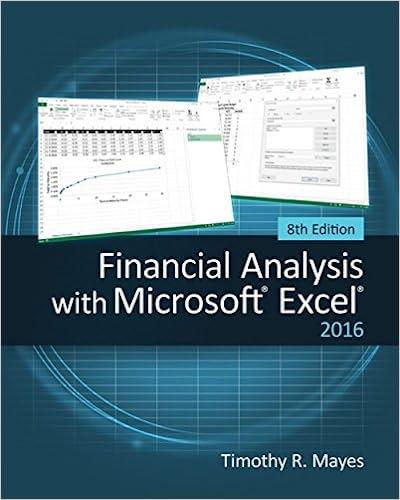Question
Following is information for the required returns and standard deviations of returns for A, B, and C. Here are the expected returns and standard deviations
Following is information for the required returns and standard deviations of returns for A, B, and C. Here are the expected returns and standard deviations for stocks A, B, and C: Stock ri si A 9.0% 30.00% B 12.0% 50.00% C 18.0% 80.00% Here is the correlation matrix: A B C A 1.0000 0.2500 0.3900 B 0.2500 1.0000 0.1650 C 0.3900 0.1650 1.0000 a. Suppose a portfolio has the distribution percentages shown below. What are the expected return and standard deviation of the portfolio? wA = 20% Standard Deviation of the Portfolio 55.00% wB = 50% wC = 30% rp = 13.20% Hint: for the portoflio standard deviation, start by creating a table like the one in Section 25.1 for the N-asset case. In fact, begin by creating a table with the products of the weights and standard deviations for each pair of stocks. If you are careful about how you construct the formulas, you can copy them. Then take the results from this intermediate table and multiply them by the correlations above. A B C wi = 20% 50% 30% si = 30.00 50.00 80.00 Hint: put the products of weights and standard deviations for each stock in this row. wi x si = 6.00 25.00 24.00 wi si wi x si A 20% 30.00 6.00 Hint: the values in this box should equal wi x si x wj x sj. B 50% 50.00 25.00 C 30% 80.00 24.00 Now multiply the products of wi x si x wj x sj by the correlations given above to create a table like the one in Section 3.1. A Hint: the values in this box should equal wi x si x wj x sj x rij. B C Portfolio variance = Hint: portfolio variance is the sum of all the values in the table immediately above. sp = b. The partial model lists 66 different combinations of portfolio weights. For each combination of weights, find the required return and standard deviation. Hint: Use the formula to calculate the variance for each portfolio and then copy it down. This formula should have six values in it: 1 for Stock A, 1 for Stock B, 1 for Stock C, one for the cross-term of A and B, 1 for the cross-term of A and C, and 1 for the cross term of B and C. Portoflio # wA wB wC Variance sp rp 1 0.0 0.0 1.0 2 0.0 0.1 0.9 3 0.0 0.2 0.8 4 0.0 0.3 0.7 5 0.0 0.4 0.6 6 0.0 0.5 0.5 7 0.0 0.6 0.4 8 0.0 0.7 0.3 9 0.0 0.8 0.2 10 0.0 0.9 0.1 11 0.0 1.0 0.0 12 0.1 0.0 0.9 13 0.1 0.1 0.8 14 0.1 0.2 0.7 15 0.1 0.3 0.6 16 0.1 0.4 0.5 17 0.1 0.5 0.4 18 0.1 0.6 0.3 19 0.1 0.7 0.2 20 0.1 0.8 0.1 21 0.1 0.9 0.0 22 0.2 0.0 0.8 23 0.2 0.1 0.7 24 0.2 0.2 0.6 25 0.2 0.3 0.5 26 0.2 0.4 0.4 27 0.2 0.5 0.3 28 0.2 0.6 0.2 29 0.2 0.7 0.1 30 0.2 0.8 0.0 31 0.3 0.0 0.7 32 0.3 0.1 0.6 33 0.3 0.2 0.5 34 0.3 0.3 0.4 35 0.3 0.4 0.3 36 0.3 0.5 0.2 37 0.3 0.6 0.1 38 0.3 0.7 0.0 39 0.4 0.0 0.6 40 0.4 0.1 0.5 41 0.4 0.2 0.4 42 0.4 0.3 0.3 43 0.4 0.4 0.2 44 0.4 0.5 0.1 45 0.4 0.6 0.0 46 0.5 0.0 0.5 47 0.5 0.1 0.4 48 0.5 0.2 0.3 49 0.5 0.3 0.2 50 0.5 0.4 0.1 51 0.5 0.5 0.0 52 0.6 0.0 0.4 53 0.6 0.1 0.3 54 0.6 0.2 0.2 55 0.6 0.3 0.1 56 0.6 0.4 0.0 57 0.7 0.0 0.3 58 0.7 0.1 0.2 59 0.7 0.2 0.1 60 0.7 0.3 0.0 61 0.8 0.0 0.2 62 0.8 0.1 0.1 63 0.8 0.2 0.0 64 0.9 0.0 0.1 65 0.9 0.1 0.0 66 1.0 0.0 0.0 c. The partial model provides a scatter diagram (shown below) showing the required returns and standard deviations calculated above. This provides a visual indicator of the feasible set. What is the standard deviation and expected return of the lowest risk portfolio? Hint: you could sort the data above by rp and sp. Minimum standard deviation Expected return of minimum risk portfolio
Step by Step Solution
There are 3 Steps involved in it
Step: 1

Get Instant Access to Expert-Tailored Solutions
See step-by-step solutions with expert insights and AI powered tools for academic success
Step: 2

Step: 3

Ace Your Homework with AI
Get the answers you need in no time with our AI-driven, step-by-step assistance
Get Started


